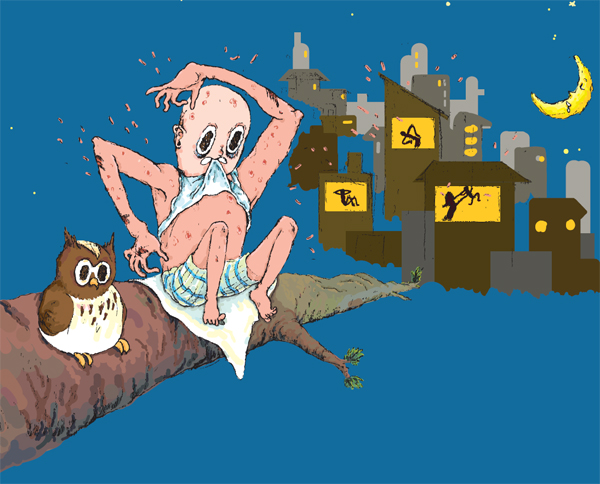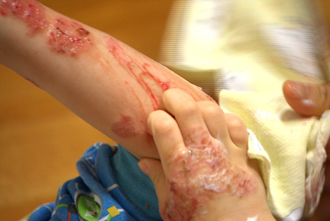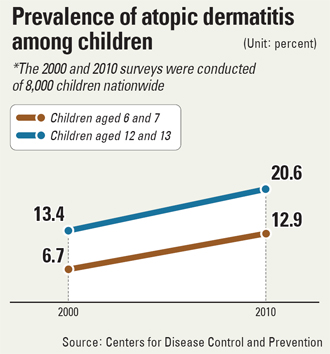Scratching out: Eczema’s terrible cost

The young girl’s condition continued to deteriorate, and last September the itchiness and rashes spread all over her body and face. It was so bad that the girl could not sleep. To make things even worse, the mother was convinced she had applied too much steroidal cream and had given her daughter Cushing’s syndrome, a rare metabolic disorder.
Unable to cope with her daughter’s sickness, the 33-year-old mother strangled her child on Jan. 20, and then hanged herself. Her husband was at work at the time, and her second daughter was waiting to be picked up from kindergarten.
It was a warm winter afternoon. The girl’s paternal grandmother, who lived on the second floor in the same building, received a phone call from the kindergarten asking why no one had picked up the other girl. She went downstairs to check on her daughter-in-law and found the bodies.
For those who have little knowledge of atopic dermatitis, also known as eczema, the mother seems heartless. But those who suffer from the mysterious ailment understand the toll the disease can take.
“Men with serious atopic dermatitis are exempt from military service. It means that society sees it as a serious disease,” said Eom Eun-hui, a senior researcher at Seoul National University Asia Center who has suffered from atopic dermatitis since she was 19. “Without knowing anything about the disease, it is too cruel to tell them, ‘Just hang in there.’”
Eom still struggles with recurrent bouts of oozing, peeling and flaky skin like other eczema patients. During bad flare-ups, she can hardly sleep or eat for weeks or months.
“The pain and the burden are beyond your imagination. It is not something an individual can handle,” added Eom.
Going out for a walk or sitting in class is impossible for many patients of eczema because the itching and scratching lead to a cycle of pain, leading eventually to infection, which causes more itchiness. It is a condition that hurts not just those with the disease, but those around them.
With atopic dermatitis cases apparently on the rise, people are wondering how much of it is caused by the environment, how responsible society as a whole is and how people can recover from the disease’s terrible impact.

Eczema causes itchiness so extreme that patients scratch until they bleed, like the child pictured here. [Screen capture from EBS Docu Prime]
Nearly one million Koreans visited clinics last year because of atopic dermatitis. But many more visited oriental medicine clinics and tried treatments such as acupuncture, aroma and spa therapies in a desperate attempt to ease the burning, raw pain.
The Atopty Association estimates there are about five million patients in Korea suffering from some degree of eczema, spending about 100 billion won ($93.3 million) on treatment. Including the related products offered to help sufferers - ointments, special clothes, mild detergents and the like - Koreans could spend as much as 1 trillion won a year treating atopic dermatitis.
The most remarkable change in recent years has been the surging number of adult patients. There were 3.1 million Koreans who suffered from eczema in 2008, nearly double the 1.7 million reported having the disease in 2002, according to the National Health Insurance Service.
“I would say it is a disease caused by environmental factors,” said Leem Jong-han, a professor of occupational environmental medicine at Inha University. “About 200 years have passed since industrialization, but we didn’t even know about atopic eczema before industrialization. People say that genes contribute to eczema, but genes can’t be changed in 200 years.”
Leem said about 200 new chemicals are added to our products every year, many of which we have little information about.
One extreme example was a sterilizing agent that was added to some household humidifiers in Korea about a decade ago. It killed 120 people before the agent was identified and removed.
Unlike many developed countries, Korea has few laws restricting chemicals that can be used in household goods, although the humidifier case played a crucial role in introducing a chemical substance control law that will be implemented next year.
“The government and private companies are working on details of the law, but it is likely to have many loopholes,” said Leem.
Living in a world awash in chemicals, individual patients and their families are left to find ways to cope on their own.

Kim, a young mother in her early 20s who has a 6-month-old baby, empathizes with the Busan mother who killed her child.
“I totally understand her,” said Kim. “My baby rubs herself until her entire body is caked with blood every night. And then I find myself screaming and yelling at her. I feel guilty because I ate a lot of bread when I was pregnant.”
It is a common belief among Korean mothers that wheat causes newborns to become affected with eczema.
Kim is a devoted mother. She lets fresh air into the apartment three times a day and washes all the linens and comforters every other day. She moisturizes her child three times a day and prepares meals with organic food. Whenever she has time, she searches the web and studies atopic eczema. She brings her child to all the famous dermatologists and oriental medicine clinics. But the baby’s condition shows no signs of improving.
Some mothers even go further than Kim in an attempt to minimize chemical irritants. They replace all their plastic food containers with glass bottles, worried that plastics emit hormone disruptors. Some polish their own rice, using a small rice polisher at home.
They are doing it not because they are fussy and neurotic but because of the nature of atopic dermatitis.
Nobody, even doctors, knows what exactly causes the irritation. Apart from some basic rules, such as moisturizing the skin frequently and avoiding harsh soaps, mothers have to observe their children closely and look for what triggers their children’s symptoms.
Nor is there any known cure for atopic dermatitis. Lotions help, but even choosing the right one for each patient is daunting.
For now, steroid creams are the only way to relieve the pain. But while steroids can be effective at first, they can cause serious side effects such as cataracts, stomach ulcers and excessive hair growth on the body when used for a long period of time.
Nah, a long-time eczema patient, believes steroids aggravated her condition. She’s been living in isolation for the last six years because her skin reacts even to rubbing caused by dressing and undressing.
“If I wear clothes, it irritates my skin and worsens the itchiness,” she said.
She first discovered rashes on her arms when she was 23. She visited clinics and followed her doctors’ instructions, dabbing topical steroid creams on her skin, but the atopic dermatitis spread to her entire body.
“Steroids worked well in the beginning, but even the strongest ones didn’t work for me after a point. And then I found myself suffering from the side effects [of the creams] rather than the atopic dermatitis itself. None of the doctors mentioned the downsides of the steroids,” Nah said.
Nah stopped using steroids and went to an oriental medicine clinic for two years, but she recently stopped that, too. Instead, she moved to an apartment located next to a mountain. She also visits a counselor, which she says helps her a lot.
“My condition keeps fluctuating, but now I’m just waiting to get better without any medication,” she said.
A 2012 survey conducted by the Seoul Medical Center of 7,000 atopic dermatitis patients found only 30 percent of them relied solely on medical clinics. The rest, especially the ones with severe conditions that prevented sleep and caused extreme itchiness, prioritized alternative treatments.
The effect on mothers
The police officer who is investigating the Busan mother who killed her atopic dermatitis-afflicted child could not comment on the ongoing case. But other experts following the case have their own beliefs.
Kim Hyang-su, a graduate student of women’s studies at Seoul National University, wrote his master’s thesis on mothers raising children with eczema. After conducting many in-depth interviews with mothers, Kim wrote that “the vague diagnosis of each child imposes more labor and responsibilities on mothers.”
These mothers are also judged constantly by their families and neighbors. “Mothers who use only steroids are thought to be harsh, but if mothers resort to oriental medicine or nonmedical treatments, they are considered ignorant,” Kim wrote. “If they care about every single thing in the environment for their kids, they are criticized for being picky, but if they don’t provide the proper environment, they are considered lazy.”
It also is very expensive and time-consuming to care for a child suffering from serious eczema conditions.
“You have to change almost everything, from what you eat to what you wear, and you have to pay for regular medical expenses,” said Bang Ji-hu, an official at the Atopy Association.
For example, many mothers make their own washing detergent by grinding up bars of soap and mixing them with washing soda.
“We estimate it costs about 1 million won each month for a single patient on average,” added Bang.
In addition, most of the steroids and moisturizers prescribed by clinics are not covered by the national health insurance.
Feeding on patients’ insecurities, the nation’s market for eczema products has grown tremendously in recent years. Although companies are not allowed to use the word “atopy,” the term widely used to refer to atopic dermatitis, they instead use related words that sound like “ato” for their products. Many of those products, from cosmetics to oriental medicine clinics to linen and clothing makers, rip patients off or exaggerate the effects of their products.
“I feel like we are the miner’s canary,” said Eom, the researcher at Seoul National University. “Having more and more atopic patients is a signal that society is turning into a bad place to live in. We can’t lean on the sacrifice of mothers anymore.
“I hope the government promotes organic farming,” Eom added, who is looking for a solution. “The public health service also should play a part in turning the already commercialized atopic medical scene around and putting it into the hands of the public sector.”
BY SUNG SO-YOUNG [so@joongang.co.kr]










with the Korea JoongAng Daily
To write comments, please log in to one of the accounts.
Standards Board Policy (0/250자)